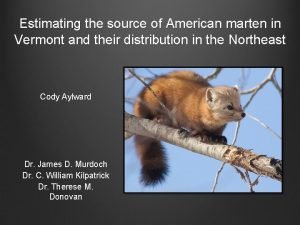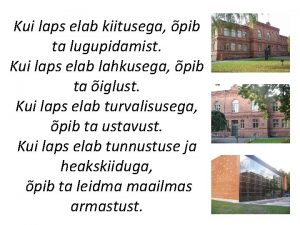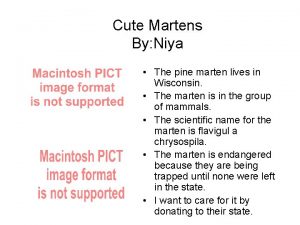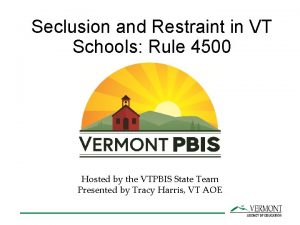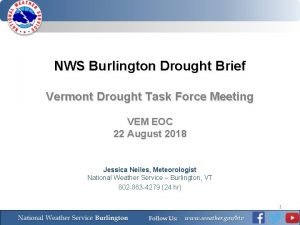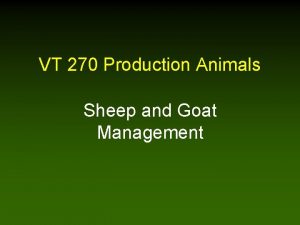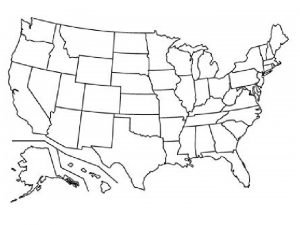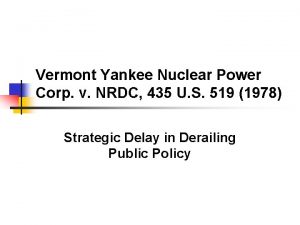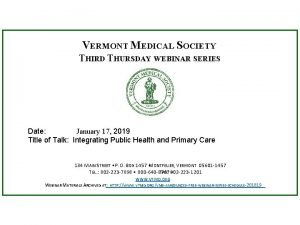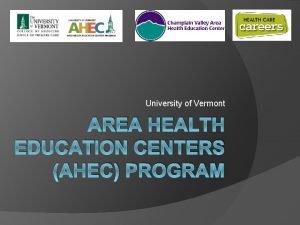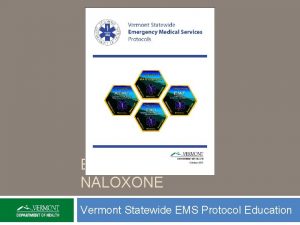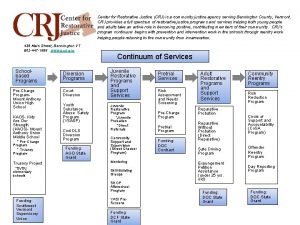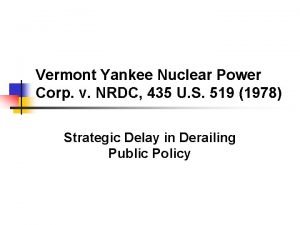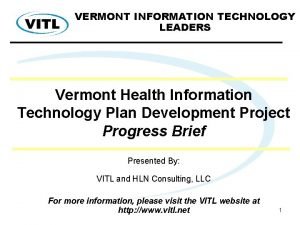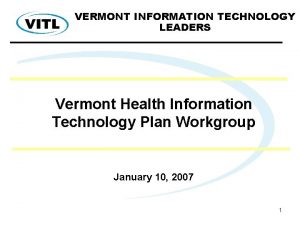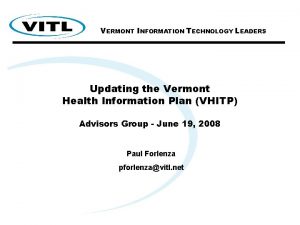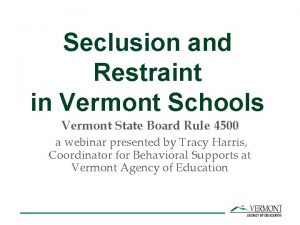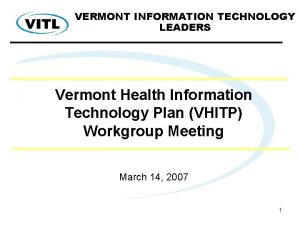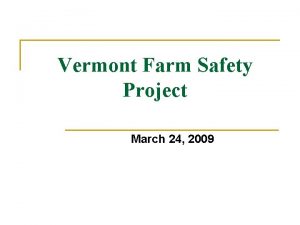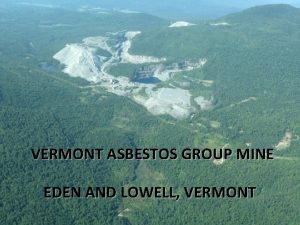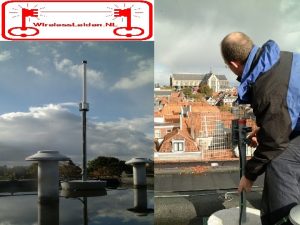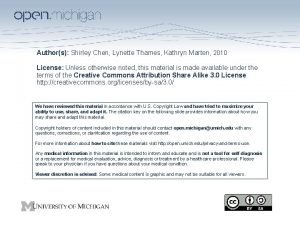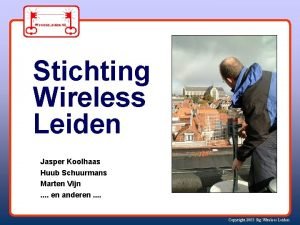Estimating the source of American marten in Vermont
























- Slides: 24

Estimating the source of American marten in Vermont and their distribution in the Northeast Cody Aylward Dr. James D. Murdoch Dr. C. William Kilpatrick Dr. Therese M. Donovan

American Marten Class Mammalia; Order Carnivora; Family Mustelidea; Martes americana Late Successional Forest Indicator Species Snow Vulnerable to Climate Change Endangered species in Vermont High priority Species of Greatest Conservation Need

American Martens in Vermont Early 1800 s – Population was plentiful and ranged throughout the state (Thompson 1853) Late 1800 s – Population decline due to habitat conversion and overharvest Last known record from Hogback Mountain in 1954 (Fuller 1987).

Reintroduction United States Forest Service and Vermont Fish and Wildlife Department released 115 individuals from Maine (n=104) and New York (n=11) in the southern Green Mountain National Forest from 1989 -1991 By 1998, monitoring efforts did not detect any individuals in Vermont

Current Status We are currently aware of two populations in Vermont: Northeast Kingdom - 1998 Southern GMNF - 2010 Questions Source? Connectivity? Other areas of suitable habitat?

Goals Determine the source to current populations of martens in Vermont using genetic markers Determine the potential distribution of martens in Vermont Identify dispersal corridors between two current populations Identify high quality habitat parcels where populations may be re-established and persist long-term Refine an expert elicitation method for modeling wildlife habitat

Methods – Population Genetics Tissue samples collected from state biologists Chris Bernier (VT), Jill Kilborn (NH), Paul Jensen (NY) and Cory Mosby (ME) DNA Extraction PCR mt. DNA (d-loop) 11 microsatellites Sequencing and Sizing Statistical tests to determine source of VT populations Fst – population differentiation Population Assignment/Exclusion

Source of Vermont Marten Populations - Hypotheses The population in Southern VT consists of descendants of the reintroduced individuals primarily from Maine Primary hypothesis The population in the Northern VT derives from migrants out of northern New Hampshire (Kelly 2005) Alternative hypothesis

Results - mt. DNA 87 individuals sequenced 12 Haplotypes identified 26 polymorphic sites Haplotype A B C D E F G H I J K L Population VT-N 6 4 3 2 0 0 0 0 n=15 VT-S 6 0 1 0 0 0 0 0 n=7 NH 3 12 3 0 0 0 0 n=21 ME 1 2 5 1 0 5 1 2 0 0 n=17 NY 10 0 0 1 0 0 9 3 3 1 n=27 All Populations 26 18 12 4 3 5 1 2 9 3 3 1 n=87

Results - mt. DNA VT-N NY VT-S NH ME

Results - mt. DNA Translocation Dispersal No significant gene flow VT-N NH Fst = 0. 44037** NY VT-S ME

Results - mt. DNA Translocation Dispersal No significant gene flow VT-N Fst = 0. 20398** NY VT-S NH ME

Results - mt. DNA Translocation Dispersal No significant gene flow VT-N Fst = 0. 20398** NY VT-S NH ME

What is next? Increase microsatellite data Population Assignment/Exclusion Identify and map genetic clusters – barriers to gene flow Hapeman et al. 2011 (http: //jhered. oxfordjournals. org/content/102/3/251. full)

Marten Distribution Develop an Occupancy Model Estimates the probability that a parcel of land is occupied based on the habitat characteristics of the land parcel Historically, occupancy models have been built using field survey data Expert opinion can tap into local knowledge of species distribution and habitat selection where field data are scarce

Methods – Expert Elicitation Identify local experts and habitat variables associated with marten occupancy Compile habitat layers in Arc. GIS and develop sampling scheme Develop survey platform for expert elicitation and distribute survey to experts Experts predict occupancy at a suite of sites Develop multiple models using logistic regression Create suite of occupancy maps Identify high-occupancy habitat patches and corridors

Expert Elicitation

% Forest Road Density Winter Precipitation Temperature Prob. 10 1. 8 31 22 0. 4 65 0. 02 23 39 0. 2 24 0. 9 55 25 0. 7 98 0 109 29 0. 6 44 2. 56 66 24 0. 8 7 8. 4 12 41 0. 1 56 1. 2 43 33 0. 4 Regressio n P(Occupancy) = 0. 43 + 0. 023*(%Forest) – 0. 35*(Road. Density)

Expert Elicitation The “Cody” Model


Circuit. Scape Dispersal corridors Pinchpoints and Barriers Sorenson and Osborne 2014 (http: //www. vtfishandwildlife. com/common/pages/Display. File. aspx? item. Id=111635)

Conclusions Reintroduction in Southern Vermont appears to have been successful mt. DNA Dispersers from New Hampshire likely contributed to colonization of Northern Vermont Role of Southern Vermont and Maine in colonization of Northern Vermont unclear Level of contemporary gene flow between VT-S and VT-N unclear

Planning/Products Better understanding of the functional/genetic connectivity of the landscape Maps of potential occupancy and corridors will be published on NSRC website (http: //nsrcforest. org/) High-occupancy parcels and corridors should be key targets for future recovery planning Map and model can be used for future research applications: Climate change scenarios Forest management scenarios

Acknowledgements Jed Murdoch Chris Bernier Bill Kilpatrick Jill Kilborn Terri Donovan Jonathan Katz APLE Fund Alexij Siren Cory Mosby John De. Pue Adam Vashon Pittman-Robertson Federal Aid Paul Jensen Northeastern States Research Cooperative Kim Royar Mc. Intyre-Stennis Rubenstein School of Environment and Natural Resources Vermont Cooperative Fish and Wildlife Research Unit Craig Nolan Expert Trappers Katy Crumley Paul Hapeman University of Vermont Department of Biology Vermont Fish and Wildlife Department Rachel Cliche Katie O’Shea
 Chris bernier vermont
Chris bernier vermont Mårten sjödell
Mårten sjödell Peter marten
Peter marten Reet meetua
Reet meetua Cute pine marten
Cute pine marten Pandas
Pandas Mårten rignell
Mårten rignell Vermont blueprint for health
Vermont blueprint for health Rule 4500 vermont
Rule 4500 vermont Forrester
Forrester Vermont drought monitor
Vermont drought monitor Vermont sheep and goat
Vermont sheep and goat Vermont dental hygiene association
Vermont dental hygiene association Central vermont railroad
Central vermont railroad Kellar
Kellar Augusta is the capital of what state
Augusta is the capital of what state Vermont yankee v nrdc
Vermont yankee v nrdc Vermont department of health
Vermont department of health Ahec vermont
Ahec vermont Vermont sheep and goat
Vermont sheep and goat Vermont ems protocols
Vermont ems protocols Crj bennington vermont
Crj bennington vermont Vermont yankee nuclear power corp. v. nrdc
Vermont yankee nuclear power corp. v. nrdc Vermont medical examiner
Vermont medical examiner Child development clinic vermont
Child development clinic vermont
